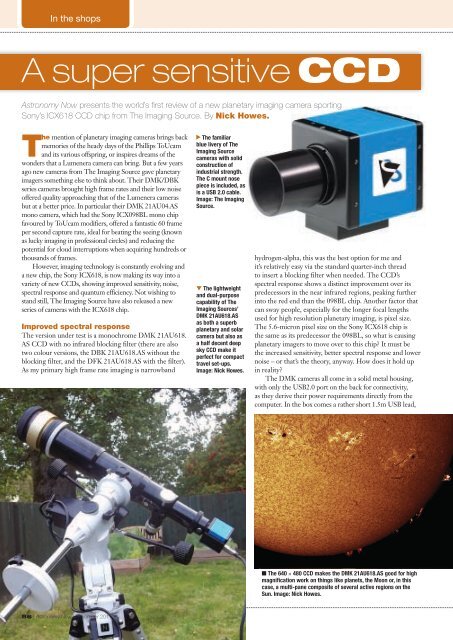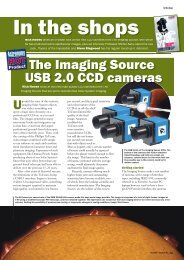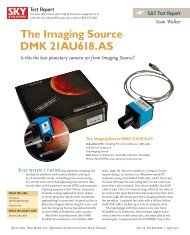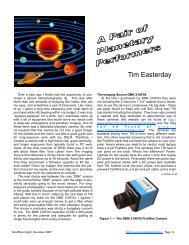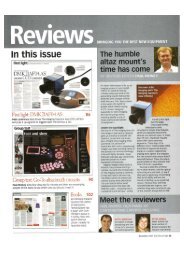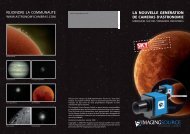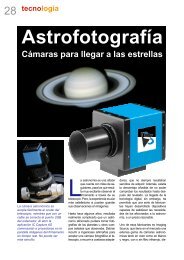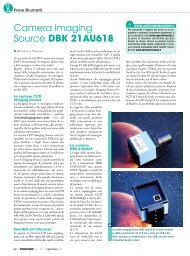A Super Sensitive CCD - The Imaging Source Astronomy Cameras
A Super Sensitive CCD - The Imaging Source Astronomy Cameras
A Super Sensitive CCD - The Imaging Source Astronomy Cameras
- No tags were found...
You also want an ePaper? Increase the reach of your titles
YUMPU automatically turns print PDFs into web optimized ePapers that Google loves.
In the shops<br />
A super sensitive <strong>CCD</strong><br />
<strong>Astronomy</strong> Now presents the world’s fi rst review of a new planetary imaging camera sporting<br />
Sony’s ICX618 <strong>CCD</strong> chip from <strong>The</strong> <strong>Imaging</strong> <strong>Source</strong>. By Nick Howes.<br />
<strong>The</strong> mention of planetary imaging cameras brings back<br />
memories of the heady days of the Phillips ToUcam<br />
and its various offspring, or inspires dreams of the<br />
wonders that a Lumenera camera can bring. But a few years<br />
ago new cameras from <strong>The</strong> <strong>Imaging</strong> <strong>Source</strong> gave planetary<br />
imagers something else to think about. <strong>The</strong>ir DMK/DBK<br />
series cameras brought high frame rates and their low noise<br />
offered quality approaching that of the Lumenera cameras<br />
but at a better price. In particular their DMK 21AU04.AS<br />
mono camera, which had the Sony ICX098BL mono chip<br />
favoured by ToUcam modifiers, offered a fantastic 60 frame<br />
per second capture rate, ideal for beating the seeing (known<br />
as lucky imaging in professional circles) and reducing the<br />
potential for cloud interruptions when acquiring hundreds or<br />
thousands of frames.<br />
However, imaging technology is constantly evolving and<br />
a new chip, the Sony ICX618, is now making its way into a<br />
variety of new <strong>CCD</strong>s, showing improved sensitivity, noise,<br />
spectral response and quantum efficiency. Not wishing to<br />
stand still, <strong>The</strong> <strong>Imaging</strong> <strong>Source</strong> have also released a new<br />
series of cameras with the ICX618 chip.<br />
Improved spectral response<br />
<strong>The</strong> version under test is a monochrome DMK 21AU618.<br />
AS <strong>CCD</strong> with no infrared blocking filter (there are also<br />
two colour versions, the DBK 21AU618.AS without the<br />
blocking filter, and the DFK 21AU618.AS with the filter).<br />
As my primary high frame rate imaging is narrowband<br />
<strong>The</strong> familiar<br />
blue livery of <strong>The</strong><br />
<strong>Imaging</strong> <strong>Source</strong><br />
cameras with solid<br />
construction of<br />
industrial strength.<br />
<strong>The</strong> C mount nose<br />
piece is included, as<br />
is a USB 2.0 cable.<br />
Image: <strong>The</strong> <strong>Imaging</strong><br />
<strong>Source</strong>.<br />
▼ <strong>The</strong> lightweight<br />
and dual-purpose<br />
capability of <strong>The</strong><br />
<strong>Imaging</strong> <strong>Source</strong>s’<br />
DMK 21AU618.AS<br />
as both a superb<br />
planetary and solar<br />
camera but also as<br />
a half decent deep<br />
sky <strong>CCD</strong> make it<br />
perfect for compact<br />
travel set-ups.<br />
Image: Nick Howes.<br />
hydrogen-alpha, this was the best option for me and<br />
it’s relatively easy via the standard quarter-inch thread<br />
to insert a blocking filter when needed. <strong>The</strong> <strong>CCD</strong>’s<br />
spectral response shows a distinct improvement over its<br />
predecessors in the near infrared regions, peaking further<br />
into the red end than the 098BL chip. Another factor that<br />
can sway people, especially for the longer focal lengths<br />
used for high resolution planetary imaging, is pixel size.<br />
<strong>The</strong> 5.6-micron pixel size on the Sony ICX618 chip is<br />
the same as its predecessor the 098BL, so what is causing<br />
planetary imagers to move over to this chip It must be<br />
the increased sensitivity, better spectral response and lower<br />
noise – or that’s the theory, anyway. How does it hold up<br />
in reality<br />
<strong>The</strong> DMK cameras all come in a solid metal housing,<br />
with only the USB2.0 port on the back for connectivity,<br />
as they derive their power requirements directly from the<br />
computer. In the box comes a rather short 1.5m USB lead,<br />
■ <strong>The</strong> 640 × 480 <strong>CCD</strong> makes the DMK 21AU618.AS good for high<br />
magnification work on things like planets, the Moon or, in this<br />
case, a multi-pane composite of several active regions on the<br />
Sun. Image: Nick Howes.<br />
86 | <strong>Astronomy</strong> Now | November 2011
In the shops<br />
▲ Familiar territory for anyone who has used cameras from <strong>The</strong> <strong>Imaging</strong> <strong>Source</strong> before is<br />
the excellent IC Capture software. Image: Nick Howes.<br />
which in my case was immediately put<br />
to one side in favour of a better quality<br />
and longer Belkin version, and the CD<br />
containing the IC Capture software and<br />
drivers. <strong>The</strong> <strong>Imaging</strong> <strong>Source</strong>’s website<br />
also claimed support for Linux and<br />
Mac OSX, but this was absent on the<br />
CD, although it is easy enough to find<br />
and download from the Internet.<br />
Installation as ever with the<br />
DMK cameras was a breeze: simply<br />
run the driver installer, plug in the<br />
camera, then run the capture installer<br />
and away you go. It’s beautifully<br />
presented as ever, and the fact that<br />
<strong>The</strong> <strong>Imaging</strong> <strong>Source</strong> provide such a<br />
capable piece of software straight out<br />
of the box is a real plus point. A hunt<br />
around the Internet also allowed me<br />
to download and test a third party<br />
ASCOM driver, which allowed the<br />
DMK to work with pretty much every<br />
piece of astro software I had. It also<br />
supports long exposure modes of up<br />
to 60 minutes (but with no cooling<br />
of any description; you’re reliant on<br />
good dark frames and the noise of the<br />
camera if you want to counter the hot<br />
pixels). IC Capture’s latest incarnation<br />
still has the occasional annoying bug<br />
that will cause the software to lock<br />
up when changing frame rates, but as<br />
that’s not a common operation once<br />
you get going and the software restarts<br />
very quickly anyway, it’s not a major<br />
issue.<br />
Peak response<br />
Set up with my various solar telescopes<br />
all worked flawlessly, only having to<br />
remember to set the AVI mode and<br />
Y800 codec on start-up of the capture<br />
software, which has cross hairs and<br />
zoom controls that help with focus.<br />
<strong>The</strong> camera has a C-mount noise-piece<br />
that slots into any quarter-inch eyepiece<br />
at the front. It’s longer than most you’ll<br />
find, which makes it tricky if you’re<br />
using something like a Coronado PST<br />
to get focus (this is a common problem<br />
with imaging on that telescope), but<br />
worked fine with the Solarscope<br />
SV50, my Vixen modified PST80 and<br />
a William Optics ZS66 fitted with a<br />
Coronado SM60II.<br />
That the peak response was<br />
over the 656nm I was imaging at in<br />
hydrogen-alpha leant itself very well to<br />
keeping the frame rate at the full 60fps,<br />
which all of my laptops handled easily<br />
and meant that the gain control could<br />
pretty much be left at a minimum, just<br />
tweaking the gamma and exposure<br />
settings to go from prominences to<br />
surface detail. It also had a marginally<br />
better peak response on the calcium-K<br />
(393nm) end of the spectrum, making<br />
imaging in this light a bit more friendly.<br />
What I did find was that the noise levels<br />
seemed higher with the gain control<br />
ramped up than for equivalent settings<br />
on my Lumenera cameras. Offset this<br />
with the improved spectral response<br />
▲ <strong>The</strong> DMK 21AU618.AS’ ICX618 chip is small in comparison<br />
to many DSLRs or <strong>CCD</strong>s for deep sky imaging, but is perfect for<br />
planetary imaging at 640 × 480, and can operate at up to 60 frames<br />
per second. Image: Nick Howes.<br />
though, and for brighter objects such as the Sun or the Moon<br />
it’s not really noticeable.<br />
Using this <strong>CCD</strong> with the infrared pass filters on larger<br />
telescopes will allow the increased spectral response to pay<br />
huge dividends. As these filters are useful in helping with<br />
seeing conditions, this alone may sway many to upgrade from<br />
the DMK 21AU04.AS to this model, but will it sway people<br />
away from the Lumeneras<br />
<strong>The</strong> DMK 21AU618.AS (I do wish they would come<br />
up with snappier names!) is not going to magically turn<br />
you overnight into the world’s best planetary imager. Years<br />
of skill, hard work and incredible seeing combined with<br />
careful post-processing skills is 90 percent of what goes into<br />
a really great image. <strong>The</strong> specifications do take some beating<br />
although I wish I’d had the other 618 cameras to test side-byside<br />
to cross verify the gain noise, because the killer feature<br />
of this package isn’t the chipset, despite its brilliance, but the<br />
fact that it is a package aimed squarely at the astro imager.<br />
Sure the sensitivity boost will help, especially when imaging<br />
planets (and by that I now include Uranus and Neptune),<br />
but it’s the all-round performance that will convince people<br />
to dip into their pockets. With their outstanding quality at<br />
good prices, this may be the hour when <strong>The</strong> <strong>Imaging</strong> <strong>Source</strong><br />
finally become the new kings of ‘lucky imaging’.<br />
Nick Howes is <strong>Astronomy</strong> Now’s Equipment Consultant.<br />
At a glance: DMK 21AU618.AS<br />
Resolution:<br />
640 x 480 pixels<br />
<strong>CCD</strong> size:<br />
0.25 inch<br />
Frame rate:<br />
up to 60fps<br />
Accessories:<br />
IC Capture software, 1.5-metre<br />
USB2.0 cable, C-mount nose piece<br />
Price:<br />
430 euros<br />
Details: www.astronomycameras.com/en/products/<br />
November 2011 | <strong>Astronomy</strong> Now | 87


